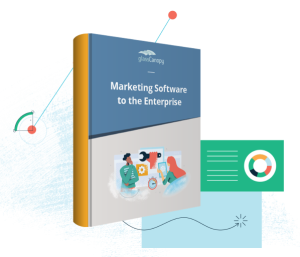Enterprise Software Marketing Strategy: The 5-Step Process to Close More Deals
Marketing complex software to enterprise businesses has little in common with selling yoga pants or office supplies. A lot of the accepted general marketing tools, tactics, and best practices just don’t work for your context.
Enterprise software marketing is a unique challenge. You have to deal with a lot of complications your B2C marketing colleagues don’t.
This blog is just a quick overview of our 5-step enterprise software marketing strategy.
For all the nitty-gritty details…
Download our eBook: Marketing Software to the Enterprise
Why Developing an Enterprise Software Marketing Strategy is Hard
Enterprise software comes at a high price point.
When someone decides to buy a candy bar in the grocery store, the stakes are low, so the decision is easy. However, when someone decides to purchase or subscribe to an enterprise software product, the stakes are much higher because we’re talking about deal sizes in the five, six, or seven figures. That makes prospects (reasonably) cautious, which makes your job harder.
You have to reach multiple audiences.
Big B2B deals rarely involve just one person. In fact, 63% of B2B purchases now involve more than four people. Those people will often be in different job roles and have different priorities and needs when it comes to your product. So, you have to create messaging that appeals to all of them.
Your product is niche.
You have to balance the need of trying to reach not only multiple audiences but multiple extremely specific audiences. 99.999% of people, and even most companies, won’t have a need for or interest in your products. You can’t cast a wide net and hope to attract as many leads as possible. You need to reach and convince a select few.
The purchasing process is long and complicated.
Winning over multiple people to make one sale is part of what makes enterprise software marketing complicated, but the purchasing process also tends to be long and involves several different touchpoints. For example, in 2021, the number of interactions most B2B companies had with a prospect before a sale was between 17 and 27. And the more your product costs, the longer and more difficult the process is likely to be. That means more work for your team to get each prospect to the point of purchase.
The product itself is complex.
Software used at the enterprise level has to do a lot. Not only does it need to effectively deliver on its main use, but it also needs to integrate with all the other related products the company is using. In 2017, enterprise companies had an average of 464 custom applications, and that number has likely increased in the years since. Getting an enterprise product working right usually requires significant customization and integrations — self-serve demos and trials can result in suboptimal experiences. So, you typically need people to actually talk to a salesperson. And nobody wants to do that until they’re 80% sure they want to buy.
The 5-Steps for a Strong Enterprise Software Marketing Strategy
Developing a concrete enterprise software marketing strategy is hard, but the right approach and tools make all the difference:
- Define your audience. You need to be clear on who you’re talking to (and all the audience segments that include) before you can create messaging that effectively speaks to them.
- Create excellent content. You’re unlikely to make the sale with just a witty ad. You need well-researched and persuasive assets (eBooks, white papers, articles, etc.) to close complex or technical deals. There’s an opportunity to stand out among a forest of identical-looking and sounding content… if you can craft one that hits just the right note of originality and credibility
- Promote strategically. Great content that no one ever sees can’t accomplish anything. You need a plan for getting it in front of your target audience.
- Measure and optimize. Track what works — and what doesn’t — to refine your strategy for better results as you go.
- Nurture down the funnel. Marketing campaigns aren’t finished when ads are deployed – make all that great content work by using it to build trust with leads and push them down the funnel to a closed deal.
All of that is a lot easier said than done.
Implementing an enterprise software marketing strategy requires a range of skill sets, a number of complex tasks, and managing a whole list of channels. However, your internal team probably has plenty on their plate already without trying to do everything a comprehensive marketing strategy requires.
Our agency provides start-to-finish content and lead generation for organizations trying to market enterprise software. We do everything:
- Develop strategy
- Write content like eBooks and white papers
- Manage ABM programs
- Build landing pages and banner ads
- Plan and place ad buys
- Install and monitor extensive analytics packages
- Report, analyze, and optimize





